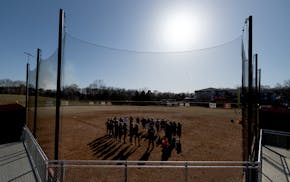A 1980s motorboat spray-painted submarine yellow carved a straight line across a calm White Bear Lake one recent morning. Then it turned and methodically crossed again, and again, as if mowing a giant lawn.
Aboard the vessel, Christopher Olson steered while Ann Merriman trained her eyes on a sonar scan of the lake's bottom. The couple, underwater archaeologists and co-founders of Maritime Heritage Minnesota, hoped to discover some history.
It's a labor of love for the St. Paul pair, who between the two, have studied underwater archaeology in Greece, examined a wrecked Civil War-era boat off the coast of the Carolinas and dove on the USS Arizona at Pearl Harbor.
Minnesota lakes tell stories, too, they say. They are working to document — but not disturb — their submerged findings for the state's archaeological records.
"It's everyday stuff that rarely gets recorded," Olson said. "It falls through the cracks of history."
When something interesting appears on the screen — sometimes dozens of times on a given lake — they document its GPS coordinates in a notebook to come back for further inspection. If it still looks interesting, they might do a dive, with the help of their volunteers, for a better look.
In nearly 20 years, the couple's nonprofit has documented more than a dozen Minnesota bodies of water, including Lake Minnetonka, Christmas Lake and Lake Waconia, as well as parts of the Mississippi and Minnesota rivers and a wreck on Lake Superior.
Now, some wrecks are under threat from blasts of boat prop wash — especially with the popularity of wake surfing, which creates an especially powerful force. Scanning water bodies for archaeological purposes requires permits, and taking anything from archaeological sites is illegal, but some divers do it anyway, Merriman said.
Merriman and Olson surveyed White Bear Lake more than a decade ago and found four wrecks and dozens of "anomalies" — things that could warrant further study. Now with improved technology, they hope to get a better picture of what lies on the bottom.
"There's just got to be more than four wrecks," Merriman said. "There's just got to be, with the amount of activity on this lake."
Dakota and Ojibwe people lived in the area of White Bear Lake before the arrival of European settlers.
With the platting of White Bear Township in the mid-1800s, out came settlers to the lake, just a short distance from St. Paul. Soon, the area was a destination for recreation, too: Resorts, cottages, yacht clubs and sailboat regattas sprang up. Later, a streetcar company operated Wildwood, a resort and amusement park that offered free admission for anyone who took their line to the shores of the lake.
Jennifer Rankin, the Minnesota Historical Society's director of archaeology, said this field gives a voice to people who might not have had one in the past. Underwater archaeology in particular provides insights into how people interacted with water, revealing social and economic ties.
"All that information is important to our understanding of or listening to the past and the lessons we take into our future," she said.
Some of White Bear Lake's history has already been lost. In the '60s, a steamboat wreck was largely torn out of the lake. Another supposed steamboat wreck has never been confirmed.
At the wheel of the boat, dubbed "Anomaly 51″ (both an archaeology and an alien joke), Olson watched the GPS to move in straight lines, or transects, across the 2,400-acre lake, which has an average depth of 20 feet. This type of work can take all day — or many, depending on the weather and the size of the lake. Sometimes he steers with his feet to reduce shoulder stress on a long day at the wheel, a trick he learned from a mentor.
Merriman sat in a chair, glued to the sonar scans.
"You're looking at the past, because that's what we just passed over," she quipped.
This kind of work is not glamorous. Merriman and Olson are funding this scan of the lake themselves, with the help of donations. While some of their work has been funded by grants, such as from the Minnesota Legacy amendment, less grant funding is coming in recently. They have taken other jobs to pay the bills and continue their work.
Merriman said boating across lakes at 4 miles per hour is not the fun part of this work. But she needs the data to find wrecks.
The wind picked up, scuttling the quality of the sonar and cutting the trip short, but the pair intend to go back soon to finish covering White Bear Lake's area. The outing did produce a few new anomalies — and a chance to check on a familiar wreck site.
"Hi baby!" Merriman shouted as, after about an hour scanning, the sonar picked up the outline of an early metal boat the two found when they last scanned the lake, much clearer this time. The wreck may be small, but it's significant, she explained. When the first metal boats came out, many people were wary they wouldn't float. Most, made of steel, haven't survived because they were melted down for other uses.
The history of boats is the history of transportation, Merriman said: Until planes and cars came around, boats took people from state to state and around the world. And there are pieces of that history in White Bear Lake, right here in the east metro.
"We get the history of technology and history of the evolution of ship construction," she said, and their work can help make sure those stories are remembered.

Golden Valley highway crash leaves one man dead; suspect in custody
Semi kills 10 cows on southeastern Minnesota highway
In South Carolina, Walz says Democrats 'need to change the attitude'
Two injured in shooting outside University of Minnesota arena after high school graduation

